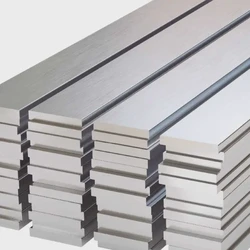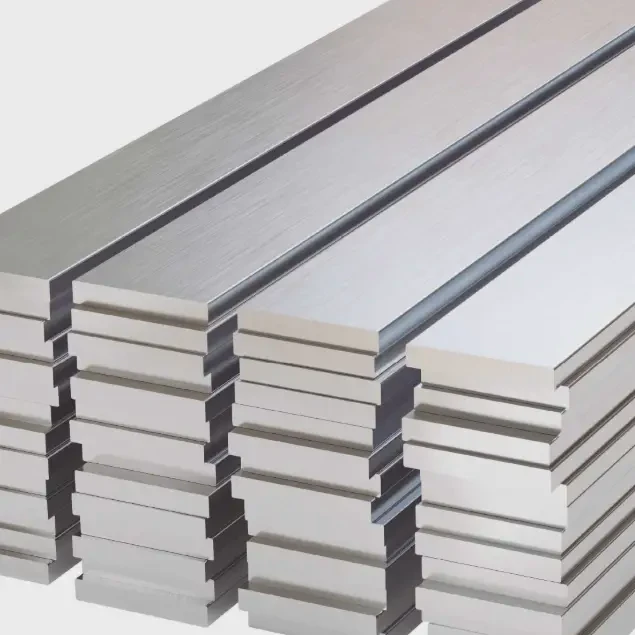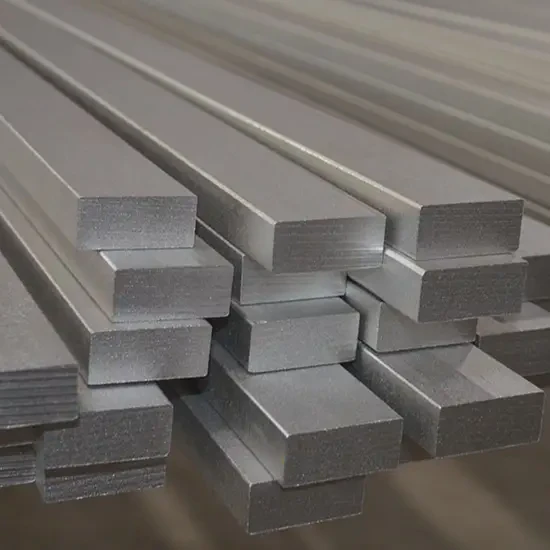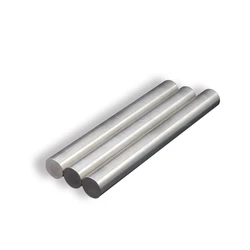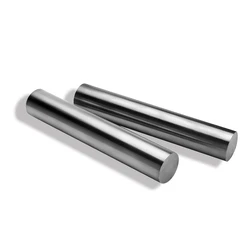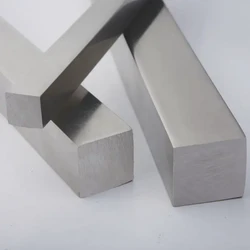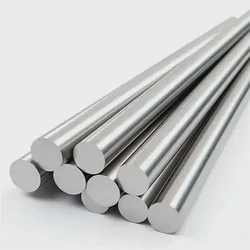Stainless Steel Flat Bar
We offer Stainless Steel Flat Bar and related grades with 100% factory direct pricing and free quotes available within 6 hours.
Stainless steel flat bars are a versatile product used extensively in various industries. Whether you're constructing buildings, creating machinery, or designing intricate components, stainless steel flat bars offer durability, corrosion resistance, and ease of fabrication. These bars, typically manufactured through hot-rolling or cold-rolling processes, come in a variety of grades such as 304, 316, and 410, each suited for different applications. Stainless steel flat bars have distinct characteristics that make them indispensable in construction, automotive, marine, and food processing industries. They provide strength, resist harsh environments, and maintain their form under extreme conditions.
1. Types of Stainless Steel Flat Bars
There are multiple types of stainless steel flat bars, each offering unique properties based on their chemical composition, manufacturing process, and surface finish. Below is a brief classification:
-
304 Stainless Steel Flat Bar: This is the most common type, known for its excellent corrosion resistance, formability, and weldability. It is commonly used in kitchen equipment, automotive parts, and general fabrication.
-
316 Stainless Steel Flat Bar: Known for its superior corrosion resistance, particularly against chlorides and harsh chemicals. It is ideal for marine environments, chemical processing plants, and food industries.
-
410 Stainless Steel Flat Bar: This grade is often used for applications requiring higher strength and wear resistance. It is less corrosion-resistant than 304 and 316 but offers enhanced hardness, making it suitable for tools and mechanical components.
-
430 Stainless Steel Flat Bar: This is a ferritic stainless steel offering good corrosion resistance in mild environments. It's often used in decorative applications, including trim and molding.
-
2205 Duplex Stainless Steel Flat Bar: Composed of both austenitic and ferritic stainless steel, it offers excellent strength and resistance to pitting and corrosion, making it perfect for high-stress and marine environments.
2. Manufacturing Process of Stainless Steel Flat Bars
Stainless steel flat bars are produced through two main methods: hot rolling and cold rolling.
-
Hot Rolling: In this method, stainless steel slabs are heated and passed through rollers to form flat bars. The high temperature allows for easier shaping, but it can result in a rougher surface finish compared to cold rolling. Hot-rolled stainless steel bars are primarily used for structural applications.
-
Cold Rolling: Cold rolling is a process where stainless steel bars are rolled at room temperature, which results in a smoother, more precise finish. The cold rolling process enhances the bar's strength and allows for tighter tolerances. Cold-rolled flat bars are typically used in applications that require precision and aesthetics, such as architectural elements.
3. Key Advantages of Stainless Steel Flat Bars
Stainless steel flat bars provide several advantages in both industrial and commercial applications:
-
Corrosion Resistance: Stainless steel flat bars resist rust and corrosion, even in harsh environments such as marine or chemical industries.
-
Durability: Known for their long lifespan, stainless steel flat bars can withstand mechanical stress and retain their structural integrity over time.
-
Aesthetic Appeal: With a sleek, modern finish, stainless steel flat bars are often chosen for their appearance in decorative or architectural applications.
-
Versatility: Stainless steel flat bars can be used for a variety of purposes, from supporting structures to creating intricate designs in machinery and vehicles.
-
Strength-to-Weight Ratio: Stainless steel offers a high strength-to-weight ratio, which helps reduce the overall weight of the final product without compromising durability.
4. Stainless Steel Flat Bar Applications
Stainless steel flat bars find applications in a wide range of industries. Here are some key sectors where they are commonly used:
4.1 Construction Industry
In construction, stainless steel flat bars are used for structural applications such as framing, reinforcement, and bracing. They are also commonly used in architectural components like handrails, staircases, and window frames, thanks to their aesthetic appeal and corrosion resistance.
4.2 Automotive Industry
In the automotive sector, stainless steel flat bars are used to make components such as bumpers, chassis parts, and brackets. Their high strength and corrosion resistance make them ideal for parts exposed to road salts and weather elements.
4.3 Food Processing Industry
Stainless steel flat bars are widely used in the food processing industry due to their hygienic properties. They are used to create machinery, storage tanks, and conveyors that come into contact with food products, as stainless steel is easy to clean and resists bacterial growth.
4.4 Marine Industry
The marine environment demands materials that can withstand harsh conditions, including saltwater corrosion. Stainless steel flat bars, particularly grades like 316, are commonly used in the construction of ships, offshore rigs, and other marine infrastructure.
5. Stainless Steel Flat Bar vs. Other Materials
While stainless steel flat bars are commonly used, there are alternative materials that may be considered depending on the application.
| Material | Corrosion Resistance | Strength | Cost | Common Use |
|---|---|---|---|---|
| Stainless Steel | Excellent | High | High | Construction, Automotive, Marine |
| Aluminum | Good | Medium | Medium | Aerospace, Electronics |
| Carbon Steel | Poor | High | Low | Construction, Heavy Equipment |
| Brass | Moderate | Medium | High | Decorative, Electrical |
6. Case Study: Use of Stainless Steel Flat Bars in Construction
A large-scale construction project in New York City involved the use of stainless steel flat bars to construct a 20-story residential building. The design required the use of stainless steel to support the building's structure, ensuring long-term durability and resistance to corrosion, especially given the harsh winter weather conditions. The use of 304 stainless steel flat bars for reinforcement and 316-grade bars for the exterior cladding significantly reduced the maintenance costs over time.
7. Factors Affecting the Cost of Stainless Steel Flat Bars
Several factors influence the price of stainless steel flat bars, including:
-
Raw Material Costs: The cost of raw materials, particularly nickel and chromium, can impact stainless steel prices. Fluctuations in these materials' prices can lead to increases in production costs.
-
Manufacturing Process: The method used to produce stainless steel flat bars (hot rolling vs. cold rolling) affects the cost. Cold-rolled bars tend to be more expensive due to the higher precision and smoother finish.
-
Supply and Demand: Market conditions and demand for stainless steel in various industries such as construction, automotive, and manufacturing can affect prices.
-
Grade of Stainless Steel: The choice of stainless steel grade also impacts cost. Higher-grade materials such as 316 stainless steel are more expensive due to their superior corrosion resistance and mechanical properties.
8. Sustainability of Stainless Steel Flat Bars
Stainless steel is an environmentally sustainable material due to its high recyclability. It can be reused indefinitely without losing its properties, making it an excellent choice for sustainable building practices. The production of stainless steel also has become increasingly energy-efficient, contributing to a lower environmental footprint.
9. FAQs
Q1: What is the difference between hot-rolled and cold-rolled stainless steel flat bars?
– Hot-rolled stainless steel bars are produced at high temperatures and have a rough surface finish, whereas cold-rolled bars are shaped at room temperature for a smoother finish and higher precision.
Q2: Can stainless steel flat bars be welded?
– Yes, stainless steel flat bars can be welded, but the welding process may require specific techniques to maintain the integrity of the material, especially with higher grades.
Q3: How do I choose the right grade of stainless steel flat bar for my project?
– Consider factors such as the environment (e.g., marine or industrial), the mechanical properties needed, and the potential for corrosion. 304 and 316 grades are commonly used for general applications.
Q4: Are stainless steel flat bars suitable for high-temperature environments?
– Yes, stainless steel flat bars, particularly grades like 310, are resistant to high temperatures and are often used in furnace components and other high-heat applications.
Q5: How do I maintain the appearance of stainless steel flat bars?
– Stainless steel is low-maintenance but may require periodic cleaning to remove dirt, oils, and other contaminants. A non-abrasive cleaner and a soft cloth are ideal for maintaining its finish.
Conclusion
Stainless steel flat bars are a critical material in many industries, offering high strength, durability, and corrosion resistance. Understanding their types, manufacturing processes, advantages, and applications helps businesses make informed decisions about material selection. With sustainability becoming a priority, stainless steel remains an essential, eco-friendly choice for future applications.
Packing And Delivery

OUR FACTORY





CUSTOMER VISIT

HONOR


Recommended Products
Send Inquiry
